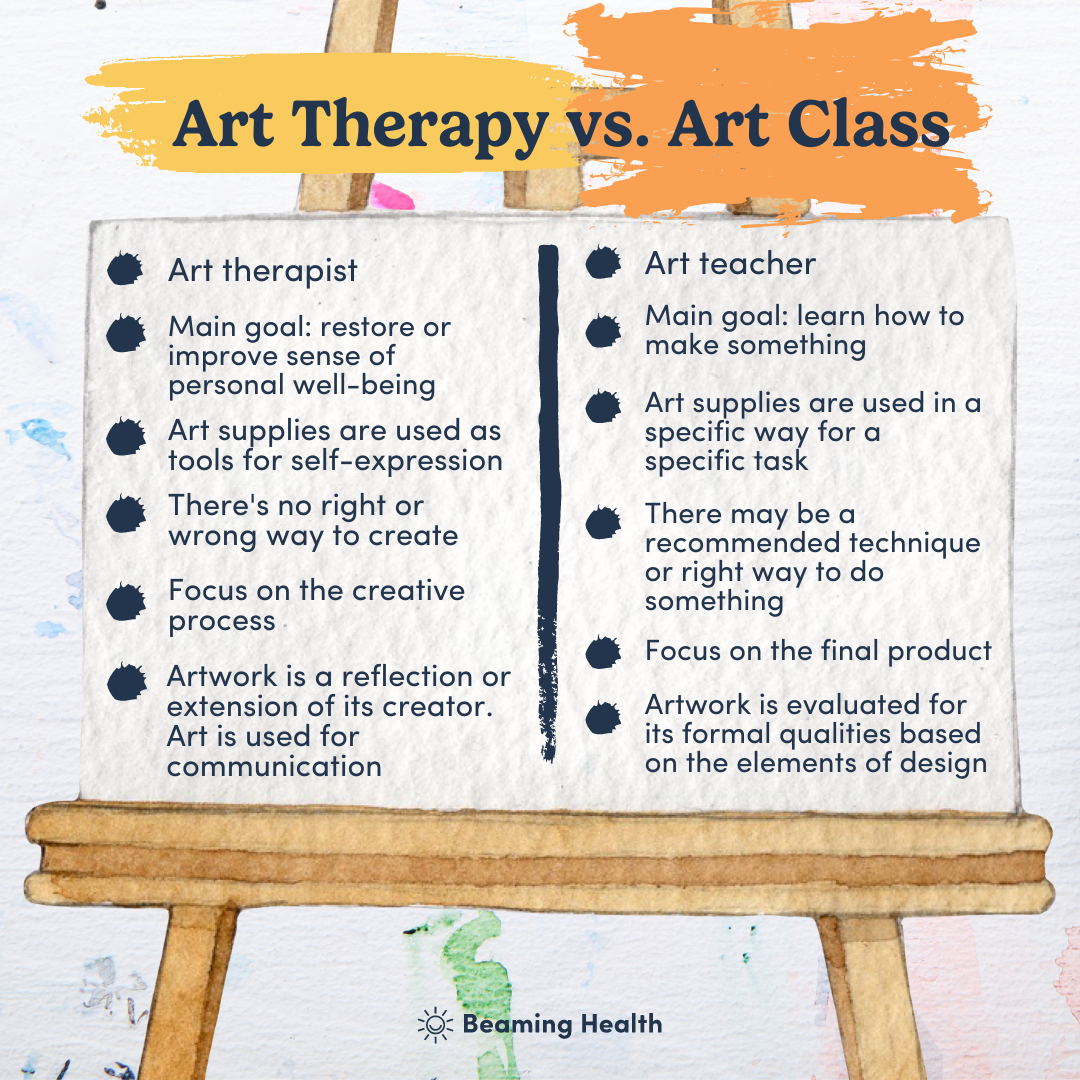Art Therapy for autistic children: Factors to consider
Updated: September 1, 2023 · 5 Minute Read

Reviewed by:
Gina Balit, MA, LMFT, ATR, founder of The Art of MFT | Child Therapy & Art Therapy
Highlights
- Art therapy is a great option for children who struggle to communicate with words. It allows children to express themselves in a safe, healthy, and healing way.
- Studies have shown that art therapy can help improve symptoms of anxiety and depression. Art therapy can improve emotional regulation and self-esteem in children with autism.
- Art classes focus on the final product and techniques used. Art therapy focuses on the process and the experience.
What is art therapy?
Art Therapy is an integrative mental health profession that helps children to communicate in a way that’s natural to them. Art and play are already part of the work we do with children as well as their language and development.
Art therapy uses art materials (paint, markers, clay, and more), a person’s creative process, as well as the resulting art product to explore and express emotions, thoughts, and feelings in a safe and healthy way.
An art therapist must deliver or facilitate art therapy. It is within the relational dynamic that healing work can be done.
This kind of therapy is often used along with other therapies, such as traditional talk therapy, cognitive behavior therapy (CBT), occupational therapy (OT), and music therapy, to help people work through their emotional and mental health struggles. It is often used to help people with anxiety, depression, post-traumatic stress disorder (PTSD), ADHD, autism, and much more!
How can art therapy help my autistic child?
Many autistic children struggle to communicate with words but have the amazing ability to think visually! This can make art therapy a great option for autistic children. Some of the benefits of art therapy for autistic kids:
- Improved communication skills: Art therapy provides a way for autistic children to express themselves without words. As they become more comfortable expressing themselves through art, this can lead to improved communication skills.
- Reduced anxiety and stress: Children with autism often experience anxiety and stress around communication and social interactions. Art therapy can help reduce those feelings by providing a calming and healthy outlet.
- Increased self-esteem: Creating art can be a confidence booster for autistic children. Seeing their own creations come to life can lead to higher self-esteem and a greater sense of self-worth.
- Improved social skills: Art therapy is a great way for children with autism to practice their social skills. Group sessions allow children to interact with others and develop social skills like taking turns and sharing.
How do I know if art therapy is right for my child?
Art therapy can be a great option for many different kids working to reach many different goals. Here are some questions to ask yourself to help you decide whether art therapy is right for your child.
- Does my child have difficulty expressing themselves with words? Art therapy allows children to communicate their thoughts and feelings without using words.
- Does my child struggle with social interactions? Art therapy can help improve social skills and reduce anxiety in social situations.
- Does my child have sensory sensitivities? Art therapy can be adapted to meet the sensory needs of children with autism.
- Does my child enjoy art? Art therapy is an excellent option for any child that enjoys art and creative activities. Art Therapy does not require your child to be an artist. They only need an appreciation for imagination, creativity, and a more dynamic way of viewing themself.
What does a session of art therapy look like?
There is no one way to provide or practice art therapy. Sessions will vary depending on your child’s specific needs and their therapist. A session may be free-flowing or very structured, open-ended, or focused on a specific goal.
A session may start with traditional talk therapy, or general art making or play for wellness or grounding. Sessions may involve specific interventions, which can result in a special product. The special product can help the child to experience or view their emotions, thoughts, and beliefs in a new way.
During a session, the therapist will note the client’s response or reaction during the art process. The therapist will be curious and ask open-ended and insight-oriented questions. They will be mindful of the child’s material and medium choice when they’re feeling a certain way or they’re seeking to feel a certain way. For example, clay might provide structure and control for kids feeling anxious. But oil pastels that are soft in texture may be frustrating to use and anxiety provoking.
Is art therapy evidence based?
Yes! Research has found that art therapy can help reduce the symptoms of anxiety, depression, and other mental health concerns. A recent study found that autistic children who participated in art therapy showed improvement in their emotional regulation, as well as their verbal and nonverbal communication skills.1
Is art therapy the same as an art class?

While art therapy and art classes may use many of the same activities, the goals and processes are different. It’s also important to note that art therapy is a continuum of practice. “Art as therapy” is at one end and “art psychotherapy” at the other. Art expression is important and can improve wellness, but without key principles, people often confuse art therapy with an art class or “project.”
Art classes focus on technique and application. Students are taught by a teacher specific art techniques and styles, like painting or sculpting.
Art therapy does not focus on a specific technique or art style. Art therapy focuses on the process and experience with the art therapist. It is non-judgmental and involves purposeful interventions that result in a meaningful product that allows clients to gain new or corrective experiences.
Is art therapy expensive?
The cost of art therapy can vary depending on many factors including:
- Where you live
- Where your child receives services (private practice vs a school or community organization)
- The credentials and experience of the therapist
- The length and frequency of the therapy sessions
- Whether your child attends one on one sessions or group therapy
- The resources need (art supplies for art therapy, equipment for EMDR, etc)
Insurance may help cover the costs of art therapy but may not cover specialty services. For example, insurance companies may not directly cover art therapy. Instead, they will cover the services of a psychotherapist who is also an art therapist and utilizes art therapy in their practice. Be sure to check with your insurance company to see if and what services can be covered by your policy.
Medical necessity is required by insurance companies. Make it clear what your interest is and that it is for medical purposes. If covered, you may need to pay for the sessions out of pocket. After, you may request an invoice/receipt (otherwise known as a superbill). Although plans and percentages vary, you may be eligible to submit these superbills for reimbursement through your provider.
To help offset the cost, some therapists may offer a sliding scale fee based on income and financial need.
How do I get started?
To get started we recommend talking to your child’s doctor or therapist. They can provide a referral to a child psychotherapist who specializes in working with autism and is a registered art therapist.
You can also use the Art Therapy Credentials Board (ATCB) directory and the Beaming Health directory to find quality providers near you!
“Art is our one true global language. It knows no nation, it favors no race, and it acknowledges no class. It speaks to our need to reveal, heal, and transform. It transcends our ordinary lives and lets us imagine what is possible.” — Richard Kamler
Get our best articles delivered to your inbox each month.
We respect your privacy.
Dive Deeper
Article References
- Schweizer C, Knorth EJ, Van Yperen TA, Spreen M. Exploring Change in Children’s and Art Therapists’ Behavior during ‘Images of Self’, an Art Therapy Program for Children Diagnosed with Autism Spectrum Disorders: A Repeated Case Study Design. Children. 2022; 9(7):1036. https://doi.org/10.3390/children9071036
- Rudy LJ. How Art Therapy Helps People With Autism: A Risk-Free Way to Help Your Child Connect With Emotions. Verywell Health. November 01, 2021. Accessed May 10, 2023. https://www.verywellhealth.com/art-therapy-for-autism-260054
- What is art therapy? Art Therapy Credentials Board, Inc. Accessed June 22, 2023. https://atcb.org/what-is-art-therapy/
- About Art Therapy. American Art Therapy Association. Accessed June 22, 2023. https://arttherapy.org/about-art-therapy/













